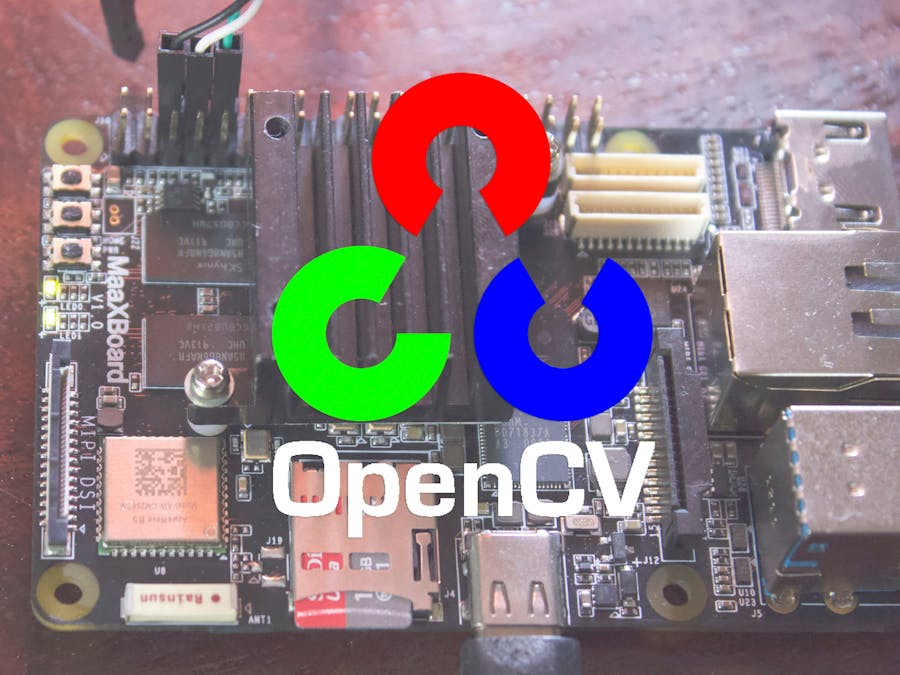Go through the tutorial here to get the MaaXBoard setup in headless mode, expand the filesystem, increase the swap file size, and set up remote desktop.
About OpenCVFrom the official website:
OpenCV (Open Source Computer Vision Library) is an open source computer vision and machine learning software library. OpenCV was built to provide a common infrastructure for computer vision applications and to accelerate the use of machine perception in the commercial products. Being a BSD-licensed product, OpenCV makes it easy for businesses to utilize and modify the code
This is one of the most comprehensive libraries for computer vision. If we want to use camera or images for our tests, we need OpenCV. This is quite a large package to compile and install. We will show two alternatives:
1. Install the prebuilt package
2. Build from the source code.
We will use OpenCV version 4.2.0. Since OpenCV is used in combination with python most of the time, we will prepare the python environment first.
Python setupThere is a list of required packages that we need to install before being able to compile/install OpenCV. They are documented here.
Some of them are also used for python image processing, so we will install all of them. This will take some bit of time to pull and install the binaries:
sudo apt-get update && sudo apt-get upgrade
sudo apt-get install build-essential cmake unzip pkg-config
sudo apt-get install libjpeg-dev libpng-dev libtiff-dev
sudo apt-get install libavcodec-dev libavformat-dev libswscale-dev libv4l-dev
sudo apt-get install libxvidcore-dev libx264-dev
sudo apt-get install git libgtk2.0-dev
sudo apt-get install libgtk-3-dev libgtk2.0-dev
sudo apt-get install libcanberra-gtk*
sudo apt-get install libatlas-base-dev gfortran
sudo apt-get install python3-dev python3-tk
sudo apt-get install libhdf5-devTo save time, you could also do it all in one step, with "yes" flags enabled, like this:
sudo apt-get install build-essential cmake unzip pkg-config libjpeg-dev libpng-dev libtiff-dev libxvidcore-dev libx264-dev git libgtk2.0-dev libgtk-3-dev libgtk2.0-dev libcanberra-gtk* libatlas-base-dev gfortran python3-dev python3-tk libhdf5-dev libavcodec-dev libavformat-dev libswscale-dev libv4l-dev -yOne of the best practice rules when working with python libraries and opencv is to create a “virtual environment” for your user where you can customize all the library versions you are going to install. This comic perfectly illustrates why this is a best practice.
You can have multiple virtualenv as long as you have space on your drive (virtualenv settings are stored into the ~/.virtualenv folder in your home directory).
We'll create a virtualenv called “cv” to work on python/opencv/tensorflow
From your home folder use these commands to download PIP (package installer for python):
wget https://bootstrap.pypa.io/get-pip.py
sudo python3 ./get-pip.pythen install the package itself and remove the leftovers
sudo pip install virtualenv virtualenvwrapper
rm -rf ~/get-pip.py ~/.cache/pipnow as user “ebv” (this was created in the prerequisite headless setup) we edit our bash shell configuration file ~/.bashrc using nano
nano ~/.bashrcand at the very bottom of it we add these lines:
# virtualenv and virtualenvwrapper
export WORKON_HOME=$HOME/.virtualenvs
export VIRTUALENVWRAPPER_PYTHON=/usr/bin/python3
source /usr/local/bin/virtualenvwrapper.shSave with CTRL+O, exit with CTRL+X and make sure you reload your shell config with:
source ~/.bashrcWhen you run this for the first time you will see the following output:
Now we can create the “cv” virtual environment itself with the command:
mkvirtualenv cv -p python3You can enter the “cv” virtual environment by typing:
workon cvNote that the prompt has now the header “(cv)” in front of it, it means you are “inside” the new env. You can exit from the virtualenv anytime by typing:
deactivateThe last package we need to install before OpenCV itself is NumPy (https://numpy.org/) which is the backbone of any numerical processing done in python. It's included in matplotlib, so we can just install that.
We want to make sure we are in the cv virtual environment before proceeding so if you deactivated it in the previous step, reactivate it now:
workon cv
pip install -U matplotlibSince there are no prebuilt packages for ARMv8-a architecture this will take quite some time to fetch, compile and install all the required packages. (expect ~20min for both)
HINT: open another console and hit the command “htop”, or use the GKrellMonitor to keep an eye on your running activity so you know what is happening on the board, here is an example of htop while installing matplotlib:
Once all the packages are installed you can double check your python installation like this: In your console type “python” to enter the python interpreter, then type:
import numpy as np
a = np.eye(3)
print (a)This will print a 3x3 identity matrix:
Hit CTRL+D to exit the python interpreter.
INSTALLING OPENCVNOTE: OpenCV is now available from pip as a package that will run on arm.
You can simply install it with this command:
pip install opencv-pythonContinue with the tutorial if you'd like to install from prebuilt sources, otherwise you're able to start using OpenCV now. Note that every time you create a new virtual environment, you'll have to simlink
OpenCV pre-built installIn this section we install and test OpenCV from.deb prebuilt packages that we have prepared for MaaxBoard. They're linked in the "Code" section.
These package have been built from source code with the instructions provided in the specific section of this howto. The files provided are:
- -rw-r--r-- 1 ebv ebv 1380918 Apr 2 16:07 OpenCV-4.2.0-aarch64-dev.deb
- -rw-r--r-- 1 ebv ebv 17355658 Apr 2 16:07 OpenCV-4.2.0-aarch64-libs.deb
- -rw-r--r-- 1 ebv ebv 15990 Apr 2 16:07 OpenCV-4.2.0-aarch64-licenses.deb
- -rw-r--r-- 1 ebv ebv 7088 Apr 2 16:07 OpenCV-4.2.0-aarch64-main.deb
- -rw-r--r-- 1 ebv ebv 1636152 Apr 2 16:07 OpenCV-4.2.0-aarch64-python.deb
- -rw-r--r-- 1 ebv ebv 1042 Apr 2 16:07 OpenCV-4.2.0-aarch64-scripts.deb
You can transfer these files on the MaaxBoard using the SCP command from your Windows (using PuttySCP) or linux laptop. For example with the command
scp ./OpenCV.zip ebv@10.0.0.245:Do not forget the “:” at the end of the command. Once they are transferred on the board, unzip them and then use your console on the MaaxBoard as user “ebv” and sudo to install them all, like this:
unzip OpenCV.zip
cd OpenCV
sudo dpkg -i ././OpenCV-4.2.0-aarch64*Now we have to create a link for our virtual environment to the installed OpenCV library. Follow these commands:
ebv@maaxboard:~$ cd ~/.virtualenvs/cv/lib/python3.7/site-packages/
ln -s /usr/lib/python3.7/site-packages/cv2/python-3.7/cv2.cpython-37m-aarch64-linux-gnu.so ./cv2.sonow enter your virtual environment and launch python:
workon cvWe are in python “interactive” mode, we can import the OpenCV library and print the version with the following lines:
python -c 'import cv2; print(cv2.__version__)'Now that we have the full python/numpy/opencv installed we can make one simple example using the remote desktop and show how to load an image in numpy. First we will retrieve one simple image for test in our home folder
cd
wget https://www.element14.com/community/themes/images/2019/MaaXBoard_front.png -O imtest.pngNow open the Geany editor by typing
geanyand type the following code:
import numpy as np
import cv2
img = cv2.imread('imtest.png',3)
cv2.imshow('image',img)
k = cv2.waitKey(10000)
Save the file in your home folder as “test1.py”
In terminal, launch the script from your virtual environment like this:
cd
workon cv
python ./test1.pyif everything is working you should see an image of the MaaxBoard popping up for 10s and then disappear.
Now let’s use matplotlib to show the image as if it was a matrix. We will import all the three installed libraries. In geany editor create a new file and save it with name “test2.py”. The script looks like this:
import numpy as np
import cv2
from matplotlib import pyplot as plt
img = cv2.imread('imtest.png',3)
plt.imshow(img, cmap = 'gray', interpolation = 'bicubic')
plt.axis()
plt.show()
Launch the script from the console window using python:
python ./test2.pyyou will see a new image popping up where the axis will show the size (in pixels) of the image itself.
Create a new folder called "test3"
mkdir test3Open geany and copy and paste the following code:
#include <stdio.h>
#include <opencv2/opencv.hpp>
using namespace cv;
int main(int argc, char** argv )
{
if ( argc != 2 )
{
printf("usage: test3.out <Image_Path>\n");
return -1;
}
Mat image;
image = imread( argv[1], 1 );
if ( !image.data )
{
printf("No image data \n");
return -1;
}
namedWindow("Display Image", WINDOW_AUTOSIZE );
imshow("Display Image", image);
waitKey(0);
return 0;
}Save the file as "test3.cpp" in the test3 folder.
Create another file and copy and paste this code:
cmake_minimum_required(VERSION 2.8)
project( test3 )
find_package( OpenCV REQUIRED )
add_executable( test3 test3.cpp )
target_link_libraries( test3 ${OpenCV_LIBS} )
Save the file as CMakeLists.txt. Generate the executable with the following commands:
cd test3
cmake .
makeNow you can run the test by typing
./test3 ~/imtest.pngOpenCV will take about ~3h to be built from source code on the target (i.e MaaxBoard). First we create a work folder “ocv” in our home folder, then we enter the folder itself:
cd
workon cv
mkdir ocv
cd ocvWe then pull the source code for opencv and opencv_contrib package:
wget -O opencv.zip https://github.com/opencv/opencv/archive/4.2.0.zip
wget -O opencv_contrib.zip https://github.com/opencv/opencv_contrib/archive/4.2.0.zip
unzip ./opencv.zip
ln -s ./opencv-4.2.0 ./opencv
unzip ./opencv_contrib.zip
ln -s ./opencv_contrib-4.2.0 ./opencv_contrib
rm *.zipIn the above list of commands, we have pulled the source code, unzip and sim-linked the code (and remove the original zip files). We can now create a build subfolder and configure the environment:
cd opencv
mkdir build
cd buildThe full command to build OpenCV has a lot of options specific to the architecture and path for contrib folder. This is the one used for this tutorial specific to MaaxBoard:
cmake -D CMAKE_BUILD_TYPE=RELEASE \ -D CMAKE_INSTALL_PREFIX=/usr/local \ -D OPENCV_EXTRA_MODULES_PATH=~/ocv/opencv_contrib-4.2.0/modules \ -D ENABLE_PRECOMPILED_HEADERS=OFF\ -D ENABLE_NEON=OFF \ -D ENABLE_VFPV3=OFF \ -D BUILD_TESTS=OFF \ -D OPENCV_ENABLE_NONFREE=ON \ -D INSTALL_C_EXAMPLES=OFF \ -D INSTALL_PYTHON_EXAMPLES=OFF \ -D BUILD_EXAMPLES=OFF ..You can copy and paste this command in your terminal on the MaaXBoard. This will launch the configuration of the build.
Once the cmake configuration is done you can launch the build with the command:
makeThis will take about 2h to complete. You then install OpenCV with the command:
sudo make installOnce you have compiled OpenCV you can also prepare the.deb packages so you can reinstall this build on a different board. There is a minor bug in OpenCV 4.2.0 regarding packetization which require you to first launch a normal installation (sudo make install) and then launch the packetization. To do so you have to modify few things:
1) In your build folder open the CMakeCache.txt and modify the line where the CPACK BINARY_DEB variable is set. It must be written as BINARY_DEB=ON
2) Edit the following files: CPackConfig.cmake, CMakeVars.txt, CPackSourceConfig.cmake
geany CPackConfig.cmake
geany CMakeVars.txt
geany CPackSourceConfig.cmakeIf the opencv version variable is set as “unknown” change it to “4.2.0”. In geany you can use replace (ctrl-H).
Now you can launch the packaging of the build with the command:
sudo make packageDebian packages will be available in the same build folder of OpenCV.
You can now symlink your build of OpenCV in /usr/local/lib/ to virtual environment with these commands:
cd ~/.virtualenvs/[ VIRTUAL ENVIRONMENT NAME ]/lib/python3.7/site-packages/
ln -s /usr/local/lib/python3.7/site-packages/cv2/python-3.7/cv2.cpython-37m-aarch64-linux-gnu.so ./cv2.soNote: I ran into one error with setting up the symbolic links for virtual environments. After running the command to create the symlink, it didn't work until removed cv2.so and then linked it again:
rm ./cv2.so
ln -s /usr/local/lib/python3.7/site-packages/cv2/python-3.7/cv2.cpython-37m-aarch64-linux-gnu.so ./cv2.soGood job! You can now use OpenCV on MaaXBoard. If you're not sure where to go next, check out these tutorials from the OpenCV docs, or look at the OpenCV page on Hackster for some more inspiration.












Comments
Please log in or sign up to comment.